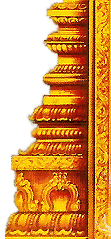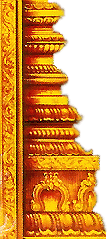|
|
Home >>
Perumal >
sri Krishnan temple
|
| |
- Details
- Path
- Map
- Photos
- Near By Temple
| |
| |
|
![[Image1]](http://img1.dinamalar.com/Kovilimages/T_500_502.jpg)
|
| | |
| | | |
|
|
|
Moolavar | : |
Lord Krishna |
|
|
Urchavar | : |
- | |
|
Amman / Thayar | : |
- | |
|
Thala Virutcham | : |
- | |
|
Theertham | : |
Madhwapushkarani | |
|
Agamam / Pooja | : |
- | |
|
Old year | : |
1000-2000 years old | |
|
Historical Name | : |
- | |
|
City | : |
Udipi | |
|
District | : |
Udupi
| |
|
State | : |
Karnataka |
| |
|
|
| |
|
|
 | Singers: |  |
| |
|
|
| |
- |
|
| |
|
|
 |
Festival: |
 |
| |
|
|
| |
Festivals: Vasantha-summer festival is grandly celebrated from the Chithirai (April-May) Akshaya Thrithiya day to Vaikasi Poornima-full moon day (May-June). Sri Rama Navami, Sri Krishna Jayanthi, Navarathri, Skanda sashti, month long puja during Mar |
|
| |
|
|
 |
Temple's Speciality: |
 |
| |
|
|
| |
Krishnar Worshipped by Mother Rukmini |
|
| |
|
|
 |
Opening Time: |  |
| | | | | |
The temple is open continuously from 4.30 a.m. to 9.00 p.m. |
|
| | | |
 |
Address: |  |
| | | | | |
Sri Krishnan Temple – Udipi-576101, Mangalore Karnataka State. |
|
| | | |
 |
Phone: |  |
| | | |
| |
+91- 820 - 252 0598. | |
|
| | |
 |
General Information: |  |
| |
|
|
| |
Lord Krishna graces the devotees in the temple facing west which has a five tiered Rajagopuram. The entrance is through the gate facing south. There is a tank on the eastern side made by the Acharya with a mandap made of stone at the centre. Mother Gangadevi graces from a shrine in the southwest corner. This was called Viraja theertha in Krutha Yuga, Ananda Sarovam in Thredha and Dwapara Yuga and now Madhwa Sarover in Kaliyuga.
Nirmalya Puja is performed from 4.30 a.m. to 5.00 p.m. Shri Madhwacharya was the first pontiff of the Mutt. Sri Vidyasakara Theertha Swamigal is the 37th pontiff heading the mutt. Of all the festivals, Madhwa Navami in February is celebrated very devotionally in the temple.
Sri Bariyaya Swamigal in the chamber near the temple kitchen graces the devotees. The government of Karnataka supplies 4 tonnes sandal to the temple to meet puja requirements.
As prayer commitments, devotees offer choice things equal to their weight (Tulabaram), cow donation and perform Car Festival to the Lord.
Sri Chandramouleeswarar and Anandeswarar temple are near the main temple. There is a shrine for Lord Shiva in Sri Krishna temple and a shrine for Navagrahas. Feeding is done both at midday and night. There is very big Cow Shed in the temple.
|
|
| |
|
|
 |
Prayers |  | |
|
| | | |
Those facing delays in marriage, seeking child boon and aspiring excellence in education pray in the temple. | | |
|
| |  |
Thanks giving: |  | |
|
| | | |
Devotees organize Rath Utsav, donate cows (Godhan) and offer Tulabara-with things equal to their weight. | | | |
| |  |
Greatness Of Temple: |  |
| |
|
|
| |
The word UDU means stars. PA means leader. The word Udupa changed as Udipi. Planet Chandra worshipped Lord Krishna here with all the 27 stars to get him freed from a curse. Hence, Lord is considered the captain of all the 27 stars and the nine planets.
Bhagwan Madhvacharya was born in the year 1238 as the son of Sri Narayana Bhattar and Smt. Vadavathi and was named Vasudeva. His Upanayanam – Holy thread ceremony- took place when he was 8. He is the proponent of Dwaida philosophy saying that God and Humans are not one but different and separate. The temple grew in fame after his life time. He reached the Lotus Feet of Lord at the age of 79 in the year 1317. While a boatman was bringing this idol by sea, he was caught in a storm. Madhwacharya controlled the storm with his divine power, rescued the idol and walked four miles chanting His glory, reached this place and installed the Lord here. His hymns are praised as Dwadasa Stotras which are sung in the temple even now. The young ascetics-Bala Sanyasis- appointed by him conducted the puja in the temple.
The door on the eastern side of the sanctum sanctorum is ever kept locked. This opens only on some special days as Vijayadasami. The priests enter the sanctum only through the other door. Devotees can have the darshan of Lord Krishna only through the nine window holes, called the Navagraha Dwaras. Lord Krishna is depicted with 24 of His different postures. There is a mandap nearby called Theertha Mandapa where the Samara and Mandala pujas are performed. Garuda Bhagwan in the Theertha mandapa was brought by a devotee named Vadiraja Theertha from Ayodhya.
In order to continue the pujas to Lord Krishna, Bagwan Madhvacharya established 8 mutts known as Ashta Mutts. They are, Krishnapoora, Bandhike, Seerur, Kaniyur, Sode, Palimer, Adamar and Bejewar Mutts. Only those belonging to these mutts are performing the pujas here. Of the eight, Krishnapoora Mutt is the important one, where pujas are performed to manuscripts of Sri Madvacharya.
The walls around the sanctum sanctorum are fixed with lamps lit on important festive occasions as Vaikunta Ekadasi, Deepavali. A special room north of the sanctum sanctorum is dedicated to the Acharya. It is believed that he is blessing the devotees in the form of lamps from this room.
It is believed that the Holy Ganga joins the Madhva Pushkarini once in a year. The water for Abishek of Lord Krishna is taken from this Theertha only. It is also believed that pronouncing the very name of the Theertha brings multi-fold benefits to the devotee, particularly in the month of Margazhi-December-January. People spill the water on their heads.
|
|
| |
|
|
 |
Temple History: |  |
| |
|
|
| |
Mother Rukmini desired to see Her Lord Krishna as an infant. She expressed Her desire to Mayan the divine sculptor. He made a Krishna Vigraha of Salagrama stone with a curd churning stick (Mathu in Tamil) in the right hand and butter in the left and named it Balakrishna. Allured by the beauty of Her Lord in idol form, Rukmini kept it with Her performing pujas. Then the idol came to Arjuna. Later, the Vigraha-idol was kept safe in Gopi Chandan.
|
|
| |
|
|
 |
Special Features: |  |
| |
|
|
| |
Miracle Based:
Lord Krishna in the temple is of Salagrama stone worshipped by Mother Rukmini.
|
|
| |
|
|
|
| |
|
|
|
|
| | Location :
Those from Chennai, Coimbatore and Palakkadu have reach Mangalore by rail or bus. Udipi is firther 60 km from Mangalore. Bus facility is conveniently available from all important places of Karnataka.
Near By Railway Station :
Udipi
Near By Airport :
Mangalore
Accomodation :
Peoples are stay in Udipi lodge.
| |
|
 |
|
|
|
|
|





